This is a shameless plug for a blog that a friend is just starting on, as she puts it, jams, chutneys and other culinary misadventures. (You’ll also see a link in the blogroll.) Delicious stuff. Share your recipes with her, if not with me!
Month: October 2009
Surprisingly for late October, a lot. Or bits of a lot. Here are just some.
Zinnias are still going strong, though we had frost on the car windshields last weekend

Cosmos are out. We have two types: pale purple and magenta purple. I prefer bold.

One surprise is that the white clematis is blooming again — and not being touched (so far) by the deer. There are five or six flowers now.
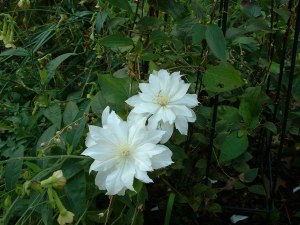
Morning glories are out too
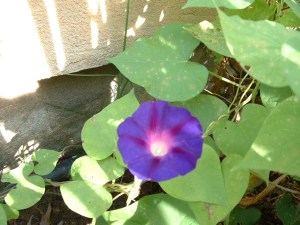
This one is like the Eveready Bunny — it just keeps on going. It reaffirms our call that Blanket Flower is an All-Star.
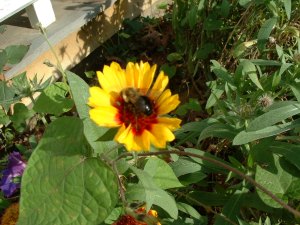
This coreopsis has a similar look
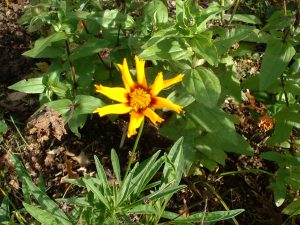
This was a hardy mum that came back (or maybe one of our Lowe’s 25-cent clearance purchases that paid off?) The clump is pretty big and I’m happy to share.
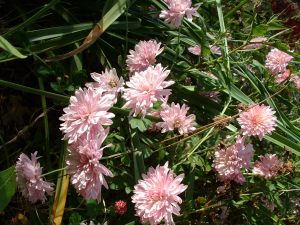

This was our first weekend in a long time when both of us were home all day for both days (OK, read that as I had nothing planned during the day). Once it stopped raining, we were able to gets lots of yard work done.
We cleared out the last of the compost, smothering some of the raised vegetable beds with several inches worth. That should make our plants pretty happy next spring!
Then we started making fresh compost so we’ll have plenty of good stuff for next year. We’ve learned from the past few years and have our short cuts. First we mow up the leaves with the mower, collecting them (and grass) in the bag. If most of the leaves are from our oaks, which take a long time to decompose, we then shred them a second time with a leaf blower/vacuum. Then we dump them in the bins. Today we filled two bins, 3 feet by 3 feet by 3 feet. Unfortunately, we hadn’t stocked up on coffee grounds this week (coffee shop by the train station knows me!) so we are relying on the grass clippings to provide enough nitrogen to ignite the heat. I’m sure we’ll add coffee grounds (also ‘green’ — leaves are carbon, ie brown) later on.
We’ll have more leaves to mulch in a few weeks. And if we don’t end up with compost, leaf mold will make us happy and replace some of the mulch we’d buy in the spring. Mike McGrath (WHYY’s You Bet Your Garden) says that while it doesn’t have the nutrients that compost has, worms love it and the casing they create are great for the soil. Here’s another take.
Vegetable beds are almost empty. The tomatoes went two weeks ago, with the aid of a three-year-old. The “volunteer” plants surprised with plenty of tomatoes. The leeks for the most part look pretty fat, and we intend to eat them around Thanksgiving. The groundhog and deer seem to leave them alone. Otherwise there’s some arugula/mixed greens that need picking.
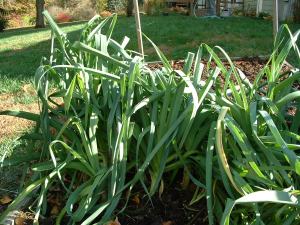
As the tomatoes disappear and the flowers die back, capture the memory with seeds. Seed-saving is easy; I’ve done it with heirloom tomatoes and I did get plants! (With hybrids, you don’t replicate the plant whose seeds you saved). I have a friend whose mother thinks it’s a waste of money to pay for tomato seeds because saving them is that easy.
So if you still have some good-looking and tasty tomatoes, push aside some of the seeds when you slice, then soak them in water in a clean bowl or jar. I’ve read they should soak for a few days, with the water changed twice a day and that the seeds need to ferment, but I’ve also done it far faster. The idea is to dissolve, or dislodge, that sack around the seed and then let them dry before packing them up (I use paper towel and a ziplock) and storing them until spring. Here’s a more “official” how-to, and there is no shortage of videos on the Web.
I know some of you have saved other kinds of seeds, so tell me how you did it.
Last step: tell me what you saved and let’s swap. I have plenty of seeds for plants that bear orange golf-ball sized tomatoes and was given some of similarly sized light yellow ones. I’m sure I have a few other as well as some bought seeds, such as what’s left of the 100-seed-pack of Super Marmande tomatoes. (I want some of those striped ones, particularly yellow and red bicolors.) All this just might keep me from ordering too many seeds this winter.
